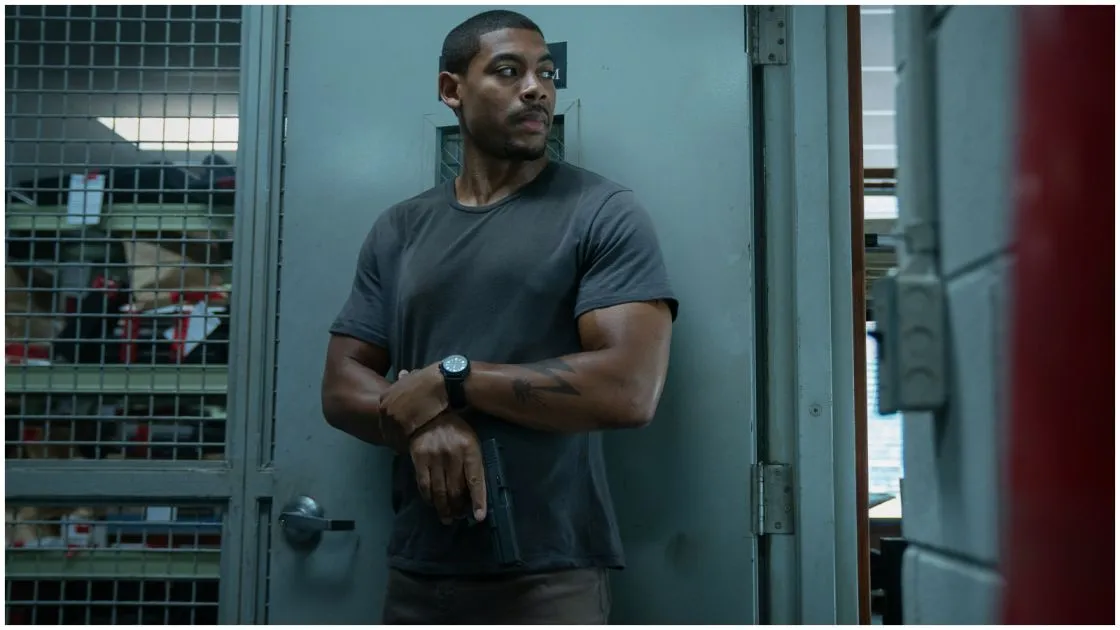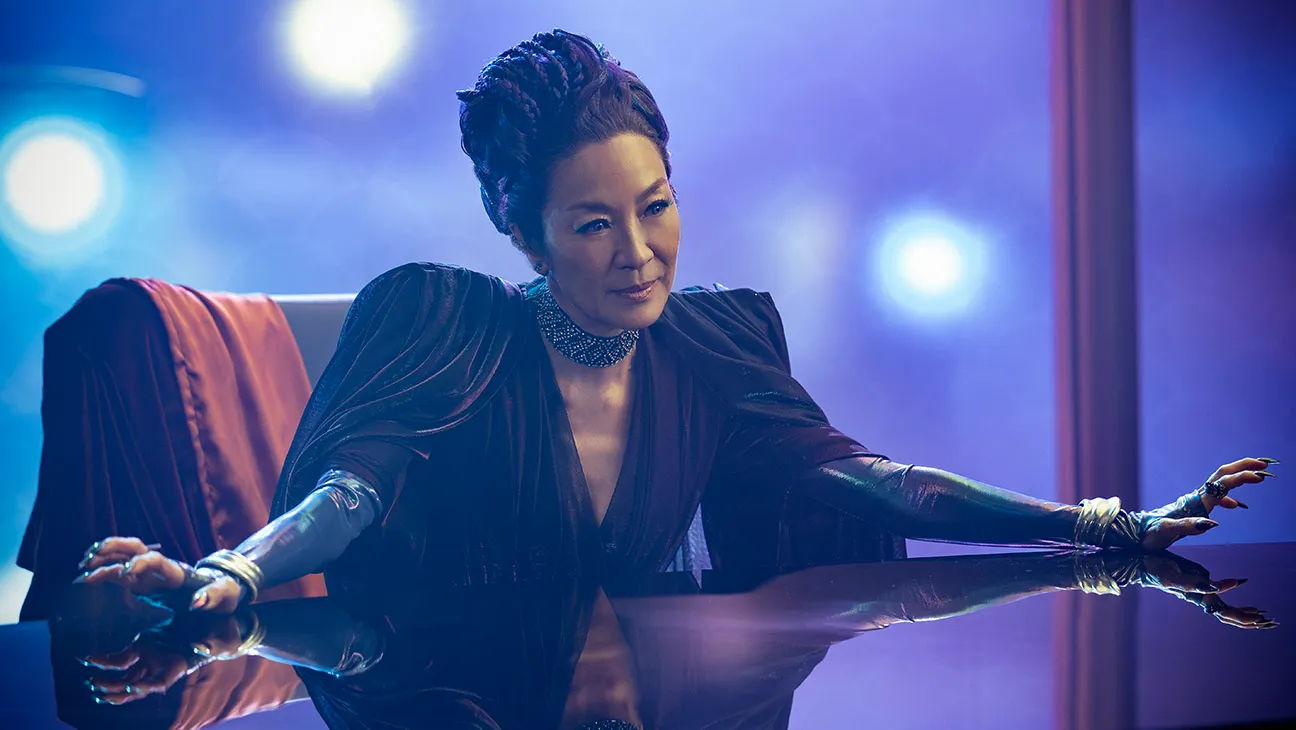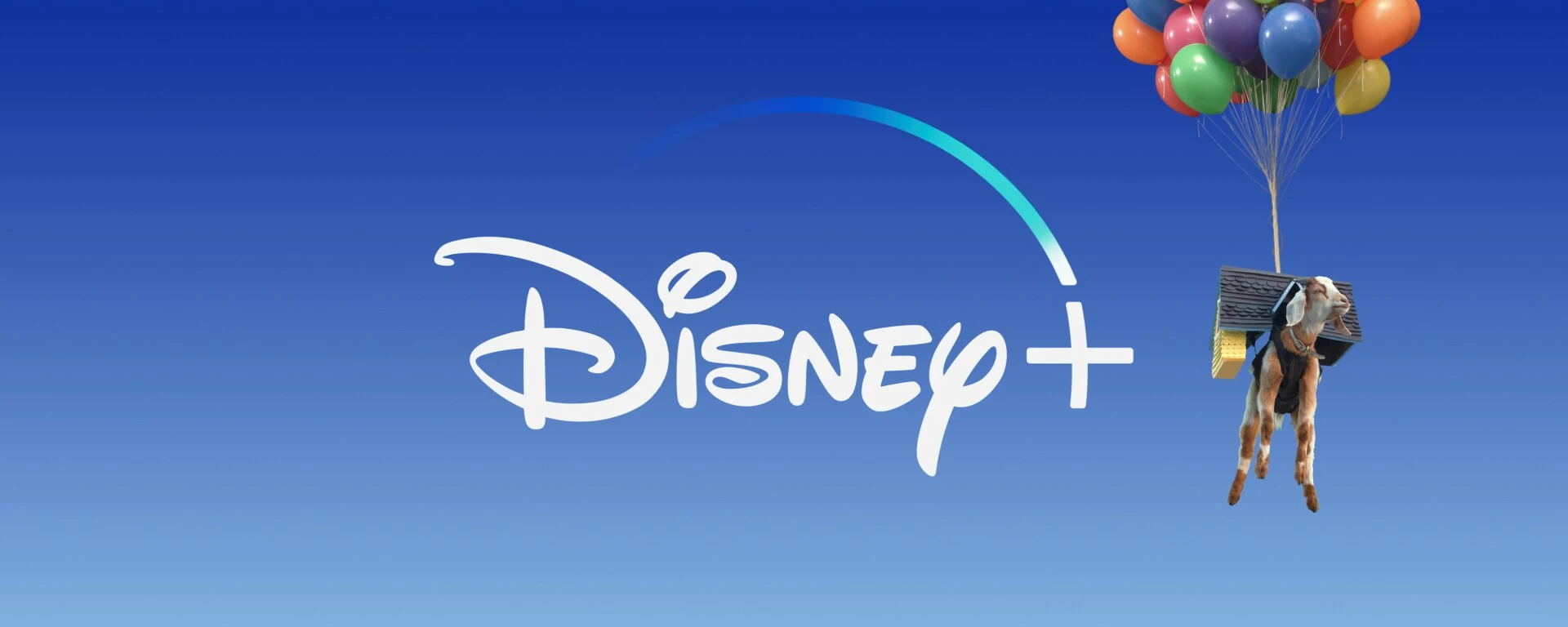Nobody was surprised that the movie of the summer, and of the year, was RETURN OF THE JEDI. It was the thrilling final(ish) installment to the biggest pop culture juggernaut in the world, it was the ultimate summer popcorn movie, the movie others had to get out of the way of, or ride the coattails of, and of undertow became by far the highest grossing movie of the year (trailed by TOOTSIE in second place).
It’s one of the two movies I remember seeing in a theater that summer. That was monumental considering I’d seen the other two at the drive-in while very young, but this one I was worldly-wise to see with slightly increasingly sensation of what was going on, and I’d bet the crazy discussions we had of it later on the playground were a little closer to what unquestionably happened in the movie. Not that I was all that savvy. I remember my family went to Burger King without the movie and got RETURN OF THE JEDI drinking glasses, which seemed like a coincidence. Hey, this is the movie we just saw! What are the chances?
That’s the sort of thing I intentionally avoided talking well-nigh when I reviewed RETURN OF THE JEDI nine years ago as part of my “Star Wars No Baggage Reviews” series. The rule was that I had to squint at episodes 1-6 as they existed at that time, in the current George Lucas-approved cuts, as if there had never been any other way to squint at that story. I couldn’t mutter well-nigh any Special Edition alterations, or lean on diaper nostalgia, or thwarting well-nigh the prequels not stuff what we’d dreamed of. It was a fun exercise designed to jettison all the stuff people usually discussed well-nigh those movies, things I was sick of hearing or talking about, and I think it was a worthwhile experiment that turned out well.
For this revisit of RETURN OF THE JEDI in the context of the summer of ’83, though, I won’t requite myself those constraints. I’ll try not to get hung up on any bullshit.
We can get the transubstantiation stuff out of the way quickly: this is the one where Lucas’ 1997 Special Edition changes scarecrow me the most. I’m not a fan of the new musical number in Jabba’s palace, and I respect what he was going for at the end, showing victory celebrations on other planets, but I miss the Ewok song. I still have the limited edition DVDs with the non-anamorphic theatrical cuts, but the blu-rays squint so much largest that I usually hold my nose and watch those. However, for this latest viewing a friend downloaded a fan-made transfer of a 35 mm print, which was veritably great. That’s the movie to me. So we shall speak no increasingly of “Jedi Rocks.”
The main thing I want to discuss in this review is why the part 3 considered by many to be the worst of the original trilogy would be, if forced to choose, my personal favorite Star Wars movie. I understand why most people prefer THE EMPIRE STRIKES BACK – the Hoth sequence is perfect, the Yoda scenes are the weightier thing in the whole series, Cloud City is cool, I think it’s the weightier looking as far as lighting, and the interplay between Han and Leia is fun. It’s a great, unconfined movie.
And there’s a weakness to JEDI that my wife has made me keenly enlightened of. She loves it too, but she tells me that growing up she found it very disappointing that her favorite character, Princess Leia, didn’t have anything to do during the big finale. To this day she loves that Leia kills Jabba, rides a speeder velocipede and feeds Wicket a rice cake, but she doesn’t like that in the last act she’s just kind of around. The heavy-lifting she has to do is emotional stuff well-nigh her relation to Luke and Vader, stuff that plays as pretty silly without you’ve seen it a few million times, so that doesn’t help. (For her part, Carrie Fisher complained well-nigh not having dialogue while enslaved by Jabba, withdrawing the refractoriness Leia was known for in the other two films. She personal that filming those scenes inspired her to wilt a writer.)
Intellectually I can moreover understand complaints that having flipside Death Star as the big weapon is an unimaginative choice, but having had the movie imprint on me at the age of 8 it’s untellable to be tightly bothered by that. I tend to stipulate with Lucas’ thinking, as expressed in story priming transcripts in J.W. Rinzler’s incredible coffee table typesetting The Making of Return of the Jedi, that a quickly understandable mcmuffin is preferable to a new weapon they have to spend time explaining, since what they’re self-glorification up to defeat the Empire is not the point of the thing. (And the trojan horse twist that it’s made to squint unfinished but is unquestionably operational is a nice touch.)
Finally, as I wrote in the other review, I hate the part where Chewie’s roar is pitch-bent to sound like a Tarzan scream. What kind of a joke is that? In so many other ways, though, RETURN OF THE JEDI is Star Wars at its best. It’s the ultimate in that surface level request of Star Wars as movies jam-packed with dazzling special effects, imaginative creatures, detailed worlds, speed and momentum. It has by far the most puppet creatures, the most model work, the fastest analog-FX ventilator sequence, the weightier original trilogy saber fight (shout out to Yoda for teaching Luke to do flips). But at the same time, as the climax of the original trilogy it has so much of the juicy emotional and thematic stuff. It’s the one where Luke redeems Vader by refusing to fight him! To me that’s the main point of the trilogy, plane increasingly so when it became a hexalogy.
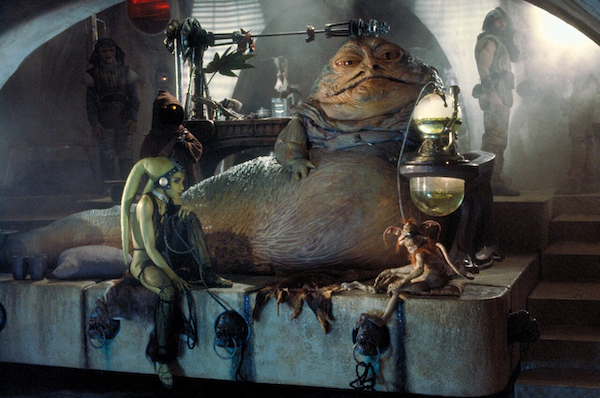
It’s the Star Wars with the most tomfool stuff in it. If you don’t think so, you must be taking Jabba the Hutt for granted. This crimelord we knew Han owed money to, and who Boba Fett captured him for, could’ve just been a guy, but he turns out to be one of the all time unconfined movie monsters. I’m not an anti-c.g. guy at all, but few digital creations seem as working as this enormous rubber slug puppet (with three operators inside moving the arms, head, tongue, and tail, one unelevated moving his mouth and making his sides heave, and others remotely executive his eyes).
And it’s not just that he looks cool, it’s moreover that he’s such a unconfined weft – his tired eyelids, slimy mouth, the way he puffs on a hookah, his deep, booming laugh and slow, subtitled speech. The way he surrounds himself with dancers, slaves, toadies, hangers-on, dancers, a house band. The cruelty of throwing both employees and enemies to the enormous Rancor that he keeps in a dungeon unelevated (another unconfined movie monster). And of undertow that little moment when Luke has killed the Rancor in self defense and its keeper cries and is consoled by a colleague. Those guys know he was just an unprepossessing and maybe know that he was a victim of Jabba as well. Like a dog trained for fights.
And there’s something uneaten fun well-nigh the heist movie format of this sequence. We know they need to rescue Han from the palace, we don’t know how they plan to do it, and we see each step of the plan (or really a series of replacement plans, it seems) unfold without foreknowledge of what they’re up to exactly. Artoo and Threepio arriving as messengers, showing the hologram of Luke, at least one of them not knowing he’s offering them as a souvenir to Jabba. Then the masked bounty hunter showing up with captured Chewbacca, impressing Jabba with his threat to wrack-up him up, but really stuff Leia in disguise, then stuff captured herself. Then Luke showing up in person, stuff waylaid by a plunge into the Rancor pit, stuff taken out to walk the plank and then turning the tables.
I’ve been asked surpassing how they unquestionably wanted it to go. I take it as a series of things to try but unchangingly with flipside idea in place when it doesn’t work. Equal to the Rinzler book, in Lucas’ pre-Kasdan-rewrite rough draft, “It’s well-spoken that his goal is to trick Jabba into the open, where it will be easier for Luke to do wrestle as a trained Jedi.” And the typesetting includes transcripts where Kasdan says, “You can seem that Luke’s plan is multilayered and the magistrate of last resort is they are going to take him to the Sarlacc pit and they’ll all be in place. But when he comes in and says, ‘I want to undear for Han,’ he is hoping that will work.”
“Yes,” Lucas says.
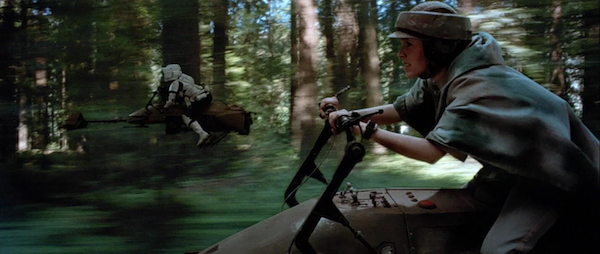
More undeniable tomfool stuff: the speeder velocipede ventilator on Endor. The rebels are there to wrack-up up a shield generator for the Death Star, they’re spotted by stormtroopers and need to take them out surpassing they warn the others, so they steal upper speed hovering vehicles and pursue them through the forest. I remember this stuff a huge deal at the time, watching and reading well-nigh how they did it, a combination of untried screen of the actors over moving footage, some miniatures, and sped up steadicam shots weaving through trees, deftly edited to create a riveting, if mostly artificial, whoopee sequence. Steadicam operator Garrett Brown had washed-up the same for THE SHINING, so he’s a legend. Joe Johnston and Dennis Muren mapped it out in an animatic using Star Wars dolls and whoopee figures in a miniature forest that included some trees left over from E.T.
Note that there’s no score in this scene – John Williams wasn’t necessary to get our hearts pumping, and this way we really hear the engines, the thirty-eight shots, the near misses, the crashes and explosions.
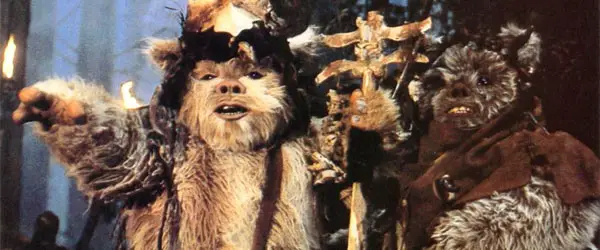
And then there’s the Ewoks. I’d offer them as flipside self-evidently tomfool part of the movie if I didn’t know there were so many who consider them the obviously terrible part. Of undertow I didn’t know well-nigh those people until I got older, considering what kind of a monster would like Star Wars but not Ewoks? It doesn’t compute to a person my age, but it’s a widespread and persistent sentiment.
Shamefully, two of these notation were created just to sell toys. The other 75 are fine.
What I’ve terminated over the years is that the anti-Ewok contingent is led by people who were teenagers in ’83, and have never let go of their “I’m a grown up now, and this is for babies” reaction to them. They contend that considering there were Ewok dolls and a storyboard that they were designed to sell toys and therefore bad. Of undertow they’re moreover enlightened that Lucas was worldly-wise to self-fund EMPIRE and JEDI considering of his shrewd licensing deals, and there’s a 300% endangerment that these same people will, at the waif of a hat, wax lovingly well-nigh which STAR WARS or EMPIRE whoopee figures, shampoo bottles and pajamas they owned as kids. Many of them have plane bought some of that kind of stuff in the decades since, but they mentally separate that from their wrongness at these particular notation in the second half of the third movie for stuff “just made to sell toys.”
A weft unquestionably unauthentic by potential toy sales was Rebel Alliance General Madine. When Kenner executives visited the set they were willful that he have a beard, since they’d once made his whoopee icon with one. But he’s not very cute, while Ewoks are “too cute” equal to detractors. They do not hold cuteness versus Jawas, Chewbacca, Droids (who moreover had a cartoon), Yoda, or their own pets or children, but they hold it versus the Ewoks. It’s not only selective, it’s moreover missing the plainly obvious unshortened idea of the Ewoks: that they’re cute at first glance but then turn out to be savage little bastards who trap our heroes and struggle to melt them. Plane without they’ve turned out to be unconfined allies and heroic saviors of the galaxy there’s that one who gleefully plays drums on the (empty?) helmets of soldiers they killed in the battle. Yeah, they kinda squint like teddy bears, that’s why motherfuckers underestimate them. That. Is. The. Joke.
It’s like getting mad at the killer dolls in BARBARELLA for stuff dolls. Why did they have to be little dolls wintry your squatter off? Why not a big menacing thing? Wouldn’t that be better? No. It would not.
The other thing well-nigh the Ewoks is that they’re the culmination of one of the themes of the trilogy. Many of Lucas’ ideas were steeped in his generation’s response to the Vietnam War and Watergate. He likened the Ewoks to the Viet Cong, as did director Richard Marquand (who I’ve read had washed-up documentaries on the war, though I haven’t been worldly-wise to determine which ones). That’s not a one-and-one analogy, obviously, but they’re a sci-fi version of locals rising up in guerrilla warfare.
In STAR WARS, Luke in his tiny little X-Wing took off his goggles and trusted in his instincts/The Gravity to make the one-in-a-million shot that destroyed the Death Star. Here this physically small ethnic tribe defeat the technologically superior Imperial unwashed using rocks, spears, arrows, logs and gliders.
That meaning is obvious and important, but I think these guys would be tomfool anyway. Seeing small creatures in an underdog wrestle versus stormtroopers on speeder bikes and in their huge mechanical walkers, taking them out with trip ropes, booby traps and hang glider bombings – what is there not to love well-nigh that? How does one enjoy this type of movie, but not fathom that? It’s invested with uneaten drama by that incredible moment when two Ewoks get knocked lanugo and one tries to help his friend up only to find him unresponsive. But again, plane without that highlight, this would be a unconfined wrestle sequence. I’m not budging on this, it’s science.
I’m pro-Ewok and I vote. I stand with the Ewoks. #EndorStrong
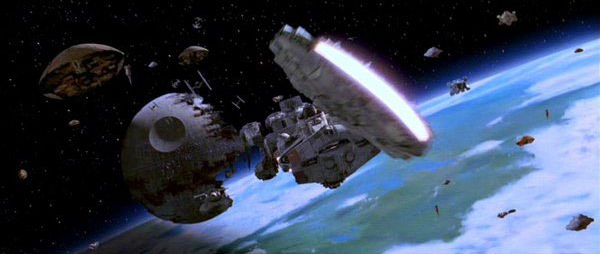
It’s moreover the one with the most elaborate space battles of the analog era. Time reported that JEDI had 942 “special effects” as compared to STAR WARS’ 545, explaining the techniques like this:
“The scenes in space were the product of highly wide matte photography. One element of a scene, an imperial wrestle cruiser, for instance, would be shot. Then flipside element, like a rebel fighter, would be photographed and superimposed on it, as if it were flipside layer on a cake. Some of the shots in the final space wrestle had 67 such layers, one on top of the other.”
That answers my question, sort of, well-nigh how they put so many moving space ships together in the same shot. Watching that 35mm transfer was heady considering in the Special Edition you know some of the shots have been replaced or altered, but watching that I found myself thinking oh shit, I forgot they could do that when then.
After the trench run in the first film, the space battles have rarely been my favorite parts of Star Wars films. They’re great, of course, they’re just not as unconfined as the other stuff. So I love that this increasingly elaborate and technologically sophisticated version of the first film’s space wrestle plays in the preliminaries of two other conflicts: Han, Chewie and Leia on the ground with the Ewoks in Endor, and Luke and Vader (who were facing each other from inside cockpits the first time) meeting IRL, rival physically, mentally and spiritually with each other and the Emperor.
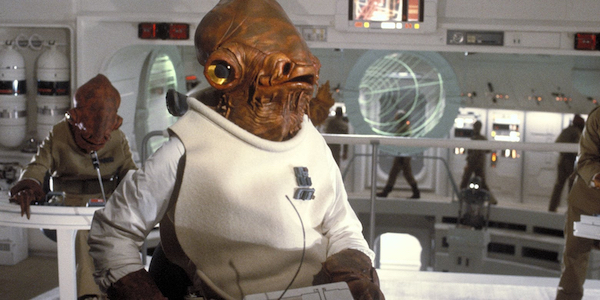
Also there’s some uneaten verisimilitude to the space battles widow by having a unconfined wayfarer weft leading the rebels. Nothing versus Mon Mothma or some guy with a beard, but obviously having a weird lobster man at the helm is increasingly exciting. In the Rinzler typesetting we learn that when Lucas realized Admiral Ackbar didn’t need to be human, he asked Marquand to pick “who’s going to play Admiral Ackbar” from all the unused wayfarer designs. Marquand chose “the most delicious, wonderful creature out of the whole lot” considering “I think it’s good to tell kids that good people aren’t necessarily good-looking people and that bad people aren’t necessarily ugly people.” He said that a few present thought it was a terrible idea and “People are just going to laugh when they see this guy.” But here we are 40 years later and it never occurred to me he could’ve been anything else. I’m glad he wasn’t!
JEDI is the one where the Emperor becomes a real character, with the indelible performance of Ian McDiarmid, a Royal Shakespeare Company vet who’d had a small part in the recent ILM project DRAGONSLAYER. The mystery of who this emperor was is flipside speciality I didn’t latch onto at the age I was as these movies came out (in fact I had a nonflexible time understanding that there was a “main bad guy” whilom Vader), but watching it now he’s such a unconfined personification of the evil of the Empire and the visionless side – physically repulsive, seems kinda pervy, openly takes lip-smacking welter in what a bad guy he is, believes he can gravity Luke to do his prompting plane while straight up telling him what that prompting is, shoots unbearable lightning from his hands to show us flashes of Vader’s skeleton. McDiarmid wasn’t plane 40 yet, but Marquand had seen him on stage playing old Howard Hughes under makeup, and correctly guessed he could play this tottering monster to slithering perfection.
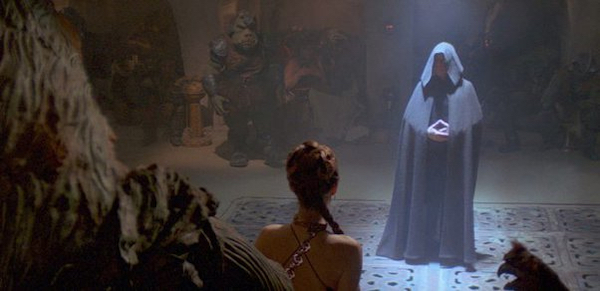
Crucially, JEDI is moreover the one where Luke is the coolest. He’s matured from whiny sublet boy to trusted rebel and now to self-declared Jedi Knight. Hamill seems much increasingly grown up and capable, he wears black, he comes into Jabba’s palace with that hood on, he has increasingly fight moves and gravity powers than before, and carries himself with confidence. When it looks like he’s painted himself into a corner he offers Jabba one last endangerment to let him go, causing the vile gangster and his posse to laugh at him, but they quickly see that he does in fact know exactly what he’s doing.
His growth goes vastitude stuff a badass, stuff good at fighting. He wins the war by yoyo in his father’s redemption and refusing to fight him. In fact he throws his light saber yonder and takes a torturous value of Gravity lightning from the Emperor, an act of endurance that awakens Vader’s humanity. Some reviews at the time mutter well-nigh shifting pop culture’s greatest villain Darth Vader to second comic status under the Emperor, but this is one of the movie’s most original and profound choices. We still get the victory over the bad guy, but the trilogy climaxes with Vader making peace with Luke, smiling at him, and dying in his stovepipe – did everyone predict that? I doubt it. It’s beautiful.
Man, Luke really loses those father figures though. First Uncle Owen, then Obi Wan, then Yoda, then Vader. Chief Chirpa is the only statesman he has left at the end, other than ghosts.
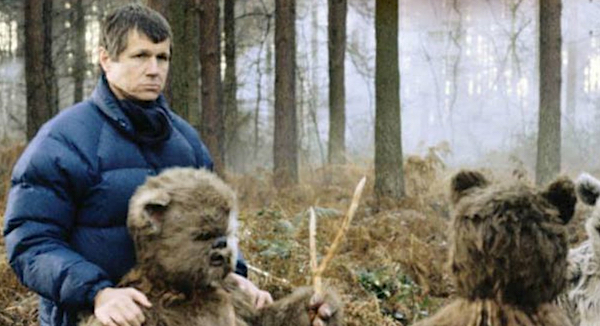
By now everyone has heard the trivia that Davids Lynch and Cronenberg were considered as possible directors, but turned it down. In the Rinzler Lucas says the list had 20-30 names on it without half were eliminated for not wanting to do a Star Wars movie. Two names mentioned in the typesetting that I’d never heard surpassing are John Carpenter and Tony Scott. But Lucas wasn’t exactly looking for a visionary. He wanted someone with TV experience, recognizing that a director having to work under a hands-on executive producer was closer to that model. He mostly considered English or Australian directors considering he was feuding with the DGA, who had tried to fine him $250,000 for putting the Lucasfilm logo at the whence of EMPIRE, ultimatum it counted as a director credit. That’s moreover why he didn’t try to talk EMPIRE’s Irvin Kershner into it.
And yet when he’d narrowed it lanugo to a Welsh director and an American who was in the DGA, he chose the American, David Lynch. Lynch says he wasn’t interested, and when people tell the legend they like to imagine it as a “what the fuck is this bullshit?” type of situation. But equal to producer Howard Kazanjian in the typesetting (from an interview conducted at the time), “I tabbed David Lynch and he was thrilled—but within three days he declined… Not long supervenient David spoken that he was going to do DUNE. So obviously he was stuff simultaneously romanced by De Laurentiis.”
The Rinzler typesetting describes Marquand’s job with detail and nuance. Some of the hairdo felt sorry for him having to operate with Lucas over his shoulder, though he seemed to take it very well for the most part. Lucas wrote the script, did all kinds of designing and planning surpassing Marquand was plane hired, and since the director was inexperienced with special effects Lucas decided to be on set as much as possible. (Time unscientific well-nigh 60% of the schedule.) Lucas shot some of the second unit and moreover reshot work by other second unit directors since what was needed for the FX team was much clearer in his head. Marquand said that his job was to serve Lucas’ vision, comparing himself to a usherette guiding an orchestra to perform the work of a unconfined composer. But he expressed frustration with Lucas making him shoot everything with multiple cameras to indulge increasingly leeway in the editing, which he felt unrespected all the planning he’d washed-up superiority of time. Still, he swore that Lucas gave him the final say on everything, and Hamill well-set that Marquand was unchangingly “captain of the ship.”
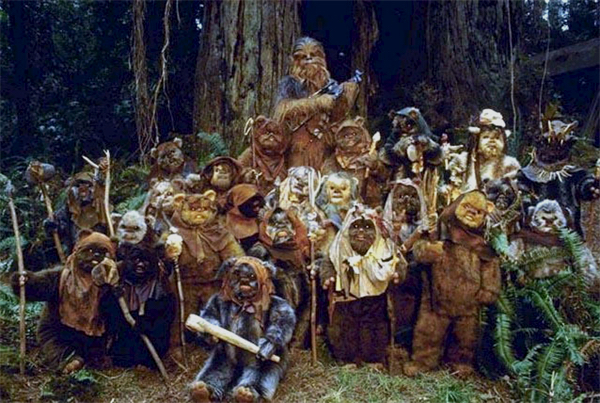
I don’t know how long it took fans to start grumbling, but RETURN OF THE JEDI was often well received upon release. Roger Ebert gave it 4 stars, opening his review talking well-nigh the crying Rancor keeper. “Everybody loves somebody,” he writes. “It is that uneaten level of detail that makes the Star Wars pictures much increasingly than just space operas.” He tabbed it “a well-constructed entertainment, a repast for the vision and a welter for the fancy… a very special work of the imagination.”
Across town Gene Siskel moreover gave it 4 stars. In The Washington Post, Gary Arnold wrote that “It was worth the wait, and the work is now an imposing landmark in popular culture… To put it flipside way, RETURN OF THE JEDI is rather obviously (but irresistibly) calculated to permit a reunited STAR WARS family — filmmakers and spectators unwrinkled — to have their confection and eat it. If the confection appealed to you in the first place, there’s certainly no reason for rejecting this lavish climax.”
Sheila Benson wrote in the Los Angeles Times that “The Jedi return to us at last, older, wiser and frankly irresistible.” She predicted that kids, “with their wriggling love of the really gross” would love Jabba the Hutt while “Adults, on the other hand, are likely to fall heavily for the small, shaggy Ewoks.”
Philip Strick of Monthly Mucosa Bulletin wrote, “If the revels of Star Wars are indeed now ended, Jedi couldn’t have been a largest resolution for them… the mucosa sparkles crisply from one peak of whoopee to the next.”
In Time magazine Gerald Clarke tabbed it “a brilliant, imaginative piece of moviemaking.” He wrote, “It is not as heady as STAR WARS itself, which had the wholesomeness of novelty. But it is largest and increasingly satisfying than THE EMPIRE STRIKES BACK, which suffered from a hectic, muddled pace, together with the archetype problems of stuff the second act in a three-act play.” He says it has “one of the corniest conclusions in recent years” but that “Despite its shortcomings, which are relatively minor in context, the mucosa succeeds, passing the one test of all rememberable fantasy: it casts a spell and envelops its regulars in a magic all its own.”
The same vendible quoted Steven Spielberg as saying, “I think JEDI is the weightier Star Wars movie overly made, and it is definitely going to be the most successful. The first movie was the introduction; EMPIRE was the second-act conflict. But they were mere canapes for this third-act opus. This is the definitive Star Wars.”
The trades were increasingly reserved. Variety’s James Harwood wrote, “The good news is that George Lucas and Co. have perfected the technical magic to a point where scrutinizingly anything and everything —no matter how bizarre—is believable,” but “the human dramatic dimensions have been sorely sacrificed.” Though the Hollywood Reporter’s Arthur Knight undisputed that “Its special effects whop the state of the art by a couple of light years, its settings are not only huge but hugely impressive, and the costuming is rich and imaginative,” he moreover lamented that “there’s a kind of desperation well-nigh it” and “the stuff of legend that inspired and elevated the older episodes has here been replaced largely by the stuff of comic books.” He reminisces well-nigh the “dizzying light show” of STAR WARS, but claims that “In JEDI there are so many light shows, so many pyrotechnical displays that the eye quickly becomes jaded.” He makes one questionable requirement well-nigh Jabba, that he “enjoys shrinking people to zest size then popping them into his vibrating maw,” which I have now learned was a worldwide misunderstanding among children considering Jabba is shown eating a frog right without he drops Oola through the trap door.
A few critics did trash the movie, including David Ansen and Dave Kehr. Pauline Kael personal it was “packed with torture scenes” and Vincent Canby tabbed it “by far the dimmest of the lot,” saying that “The film’s wrestle scenes might have been impressive but wilt tiresome considering it’s never unrepealable who is zapping whom with those laser beams and neutron missiles.”
Leave it to the genre printing to be the most finicky. Cinefantastique (one of my favorite magazines despite hosting many of the grouchiest critics around) ran side by side positive and negative reviews, and plane the positive one (by Joseph Francavilla) starts off saying “It’s probably useless to mutter well-nigh the simplistic ideas and unappetizing notation in RETURN OF THE JEDI, the illogical plot developments, the insufferable cuteness or ludicrous repulsiveness of the aliens, the improbable scenes of Leia strangling Jabba or the Ewoks defeating the invincible Imperial technology with primitive weapons, and the untellable ‘sound’ of explosions in the vacuum of space.That would be like expecting profound world literature in comic books.” At the end he bizarrely complains that “In the two prints I saw, the mucosa was scratched or marked in the scene where Vader first steps out of his ship and moreover where the Emperor first arrives to requite his men a ‘forceful’ pep talk,” and then nitpicks other shots he says have visible matte lines or wires.
The thumbs lanugo review by Michael Mayo calls it “an empty movie… a flaccid tale that deals only in vague generalities considering Lucas can’t seem to imagine anything specific to do with either emotions or people… the dead-end narcissism of a filmmaker trying to disguise his hate of the whole process with the collaboration of an regulars self-hypnotized into yoyo this is the Real Thing… By turning his when on intelligence and originative integrity, he has wilt the king of shaggy midgets, plastic toys and ten year olds. I hope he enjoys what he’s built.”
In a side bar of sheathing reviews, 5 contributors gave it either 3 or 4 stars out of 4, except for future Video Watch Dog editor Tim Lucas, who gave it 2 and tabbed it “perfunctory” and “philosophically Californian.” But a side vendible by editor Frederick S. Clarke argues that “the makeup illusions provided by the company’s newly instated ‘Monster Shop,’ supervised by Phil Tippett, don’t hold a candle to recent upbringing in the field.” The vendible says that makeup veterans Dick Smith and Stan Winston both turned lanugo the job considering they would’ve been required to relocate their shops to San Rafael to be near ILM. Clarke disapproves of choosing stop-motion genius but non-makeup-guy Tippett to be in charge, while supporting that “his work was exceptional” with puppet notation such as the Rancor. He claims everything else “fell flat,” giving only “the stiff, inexpressive” Gamorrean Guards as an example.
People who disagreed with Cinefantastique on that include The Academy of Motion Picture Arts and Sciences, who included Tippett with Richard Edlund, Dennis Muren and Ken Ralston in a “Special Achievement Award for Visual Effects,” and the Saturn Awards, which gave Weightier Make-up to Tippett and Stuart Freeborn. (JEDI was moreover nominated for art direction, original score, sound effects editing and sound Oscars, losing to FANNY AND ALEXANDER for the first and THE RIGHT STUFF for the rest.) But I found that vendible interesting to read 40 years later as a cautionary tale for us know-it-all mucosa writers who get hung up on things outside of the movies. Here’s a specimen where some inside baseball convinced the founder of one of the unconfined genre magazines that ILM totally blew it with the creatures in RETURN OF THE JEDI. It’s a powerful reminder to those of us who write well-nigh movies to be very sure we’ve crawled all the way out of our own ass surpassing settling lanugo at the keyboard.
On the other hand, maybe everyone was doing their job there. JEDI was a sci-fi/fantasy/space movie good unbearable for the mainstream critics not to turn their noses up to it, so they did the right thing, they got dazzled by a dazzling movie. And Cinefantastique came to it from a variegated wile as the very serious grown ups who knew genre movies and were gonna cut ‘em unshut with a scalpel to make sure everything was in order. These guys weren’t trying to be cheerleaders for “geek culture” like the later Ain’t It Tomfool generation, they were trying to be scholars. Veterans of mimeographed fanzines growing into authors of obscure reference books you’d find at the library. They did not skip into theaters looking for “geekgasms,” they sat with their stovepipe folded and their brows furled, vaguely unshut to the possibility of stuff impressed. I don’t like it or relate to it when they seem totally joyless, but I’d rather read grumpy but insightful than enthusiastic but empty.
I’ll never know how to squint at RETURN OF THE JEDI from that perspective, considering I’ve once lived five times as much life with it as I overly did without it. Some complaints in the 1983 reviews seem comical now – it’s like, “Sorry, bud, this is settled law. We’re not gonna entertain your idea that Jabba is too gross.” Meanwhile, some of the complaints well-nigh the notation and the story I’m now worldly-wise to step when and say, “Okay, yeah, I can see that.” And yet it’s untellable for those things to scarecrow me. The movie dug too deep into my imagination, the two got tangled up, like two trees growing too tropical together.
The whole Star Wars saga is inspired by myths and fairy tales, and to me it has wilt one. I winnow the wholesale strokes of the story – Luke’s father is Vader, his sister is Leia, Yoda sends him to confront Vader to wilt a true Jedi, the Emperor thinks if he kills Vader the opposite will happen, he will come over to the visionless side. But he refuses to skiver Vader, which brings Vader yonder from the visionless side, and redeems him. The return of the Jedi.
Around and in between those story points, variegated meanings and understandings grow. In that sense – apologies everybody, I’m gonna say it – it’s Biblical. As a literal story, much of it is nonflexible to swallow. Vader was, at minimum, involved in self-glorification up Leia’s planet. And he strangled some co-workers and tortured his secret daughter. Would you really consider a guy who did that redeemed so quickly? In the real world, no, but this is not the real world. It’s working on a increasingly operatic level. We winnow that this is the story, plane if it doesn’t make sense, so now how do we interpret it? In our world we can aspire to Luke’s compassion and non-violence, to Vader’s change, to Luke’s forgiveness, and this is an segregation well-nigh that, not a prediction of exactly what it would squint like.
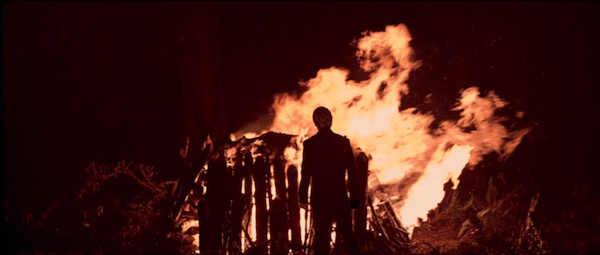
On this latest viewing I was most captured by that climax and the question of whether or not it was the lesson Yoda intended Luke to learn. Yoda says, “You must confront Vader. Then, only then, a Jedi will you be. And confront him you will.”
Luke assumes that ways to skiver Vader, and Ben seems to take it that way too. When Luke tells Ben, “I can’t skiver my own father,” Ben says, “Then the Emperor has once won.”
But Ben is wrong. Luke defeats the Emperor specifically by refusing to skiver his own father. So my question now is, did Luke save the day by disobeying Yoda and finding a largest way? Or was Yoda deliberately zipped so that Luke would have to find this solution on his own, thus rhadamanthine a true Jedi? And if that’s what it is, then is this lesson officially the Jedi way, or is it Yoda’s new take on it without the failures of the Jedi order and their war that sent him into exile in the swamp? Maybe Yoda reverted his philosophy late in life, like Malcolm X did. That’s a reading informed by my interpretation of what happens in the prequels, but I think it moreover fits with what we know of the backstory just from this trilogy.
I like that RETURN OF THE JEDI has unbearable on its mind, and unbearable empty space in between, for me to alimony thinking well-nigh it variegated ways 40 years later. Moreover I like that it has Jabba and speeder bikes and Ewoks. It’s not deep, it’s not kiddy fluff, it’s both, somehow. I think that makes it a unconfined movie. Celebrate the love.
Tie-ins: I trust I don’t have to list all the RETURN OF THE JEDI merchandise and video games and shit that exist. There was a bunch. I will mention that the novelization came out two weeks surpassing the movie (SPOILER ALERT!) and was written by James Kahn, who has an interesting biography. He went to medical school and then trained and worked in various emergency rooms but worked as a writer on the side. When he and his department were contacted to work as medical consultants on E.T. he ended up playing the doctor who declares E.T. dead. On set he gave one of his sci-fi novels to Spielberg, which got him the gig writing the novelization of POLTERGEIST. That led to RETURN OF THE JEDI followed by INDIANA JONES AND THE TEMPLE OF DOOM, THE GOONIES and POLTERGEIST II: THE OTHER SIDE. He moreover wrote for TV shows including Star Trek: The Next Generation and Xena: Warrior Princess for many years, then became a folk musician. Not bad!
The Ewoks, including Warwick Davis as Wicket, returned in November of the pursuit year with the ABC TV movie THE EWOK ADVENTURE (a.k.a. CARAVAN OF COURAGE). Its superior followup, EWOKS: THE BATTLE FOR ENDOR first aired in November of ’85. A few months earlier, The Ewoks and Droids Adventure Hour – two storyboard shows produced by Canada’s Nelvana volatility (ROCK & RULE) – began walk on ABC Saturday mornings. Droids lasted for one 13 episode season (plus a special) while Ewoks last two seasons, totaling 26 episodes. The Ewoks win again.
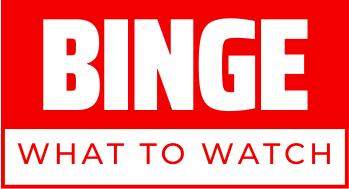

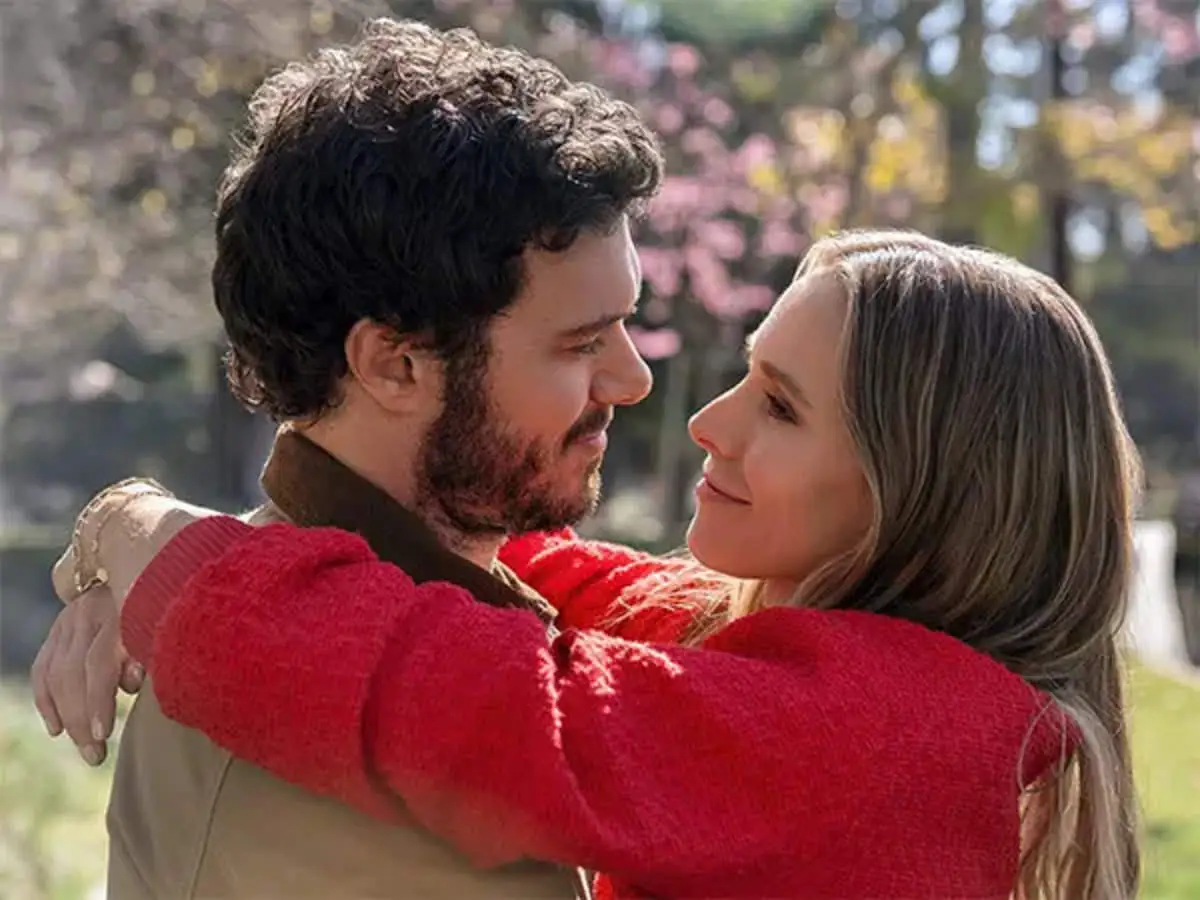

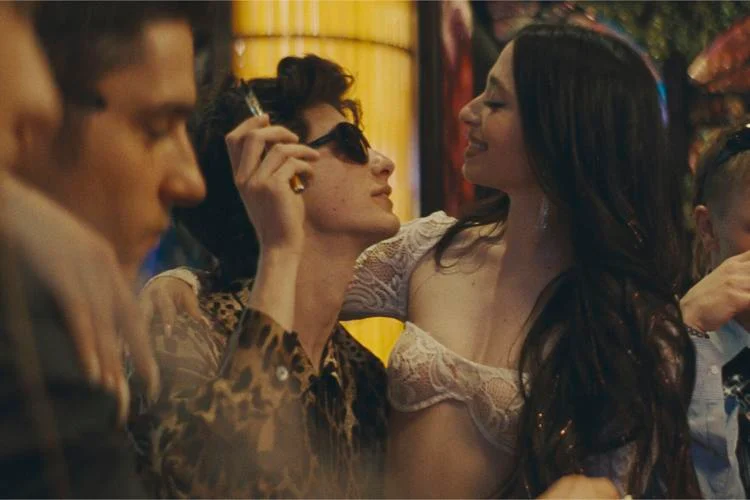

.webp)
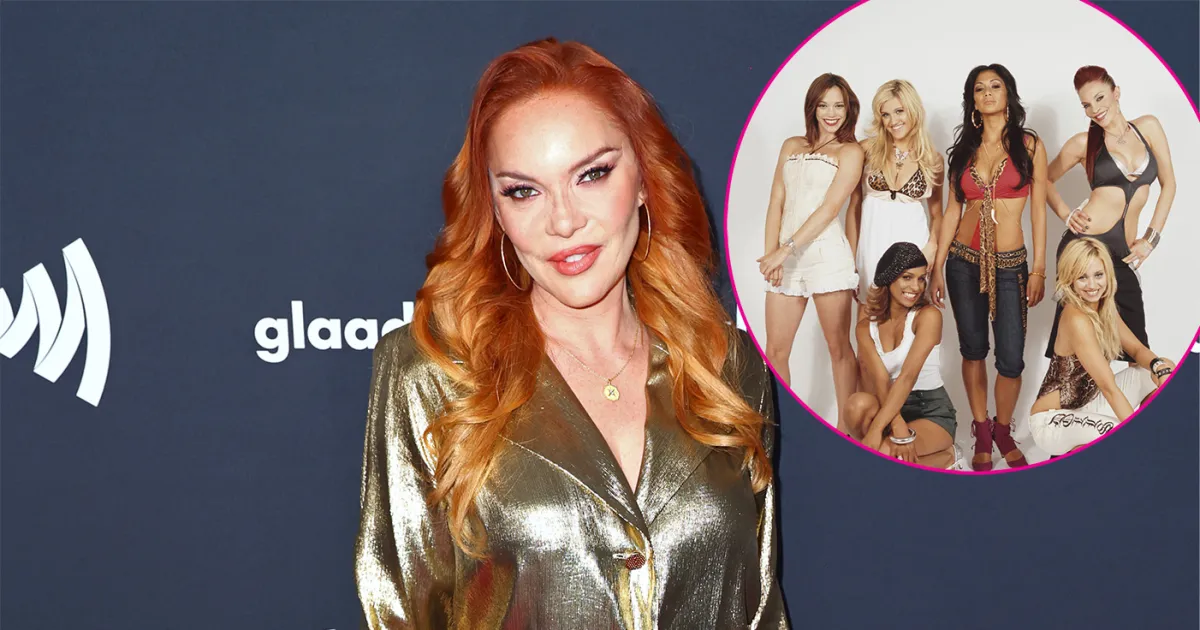
.jpg)
